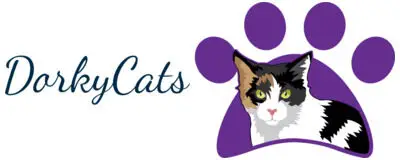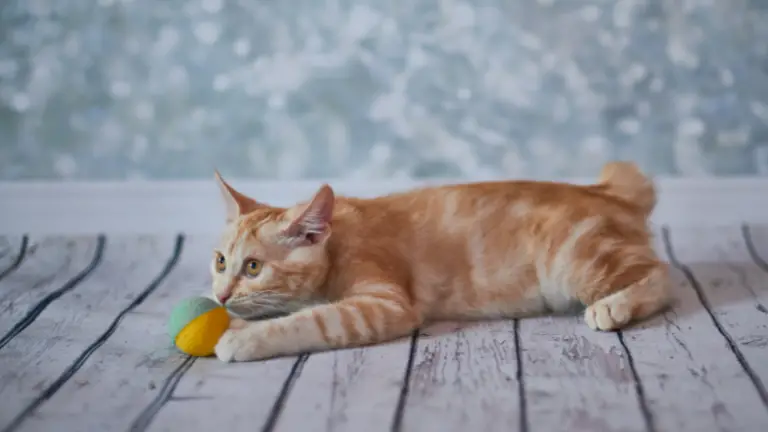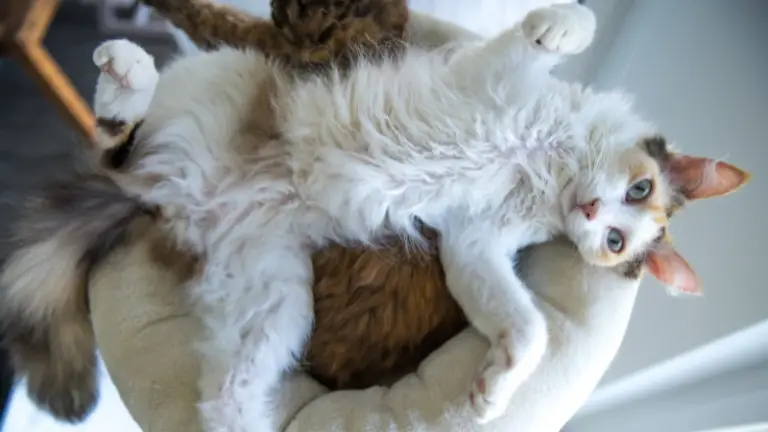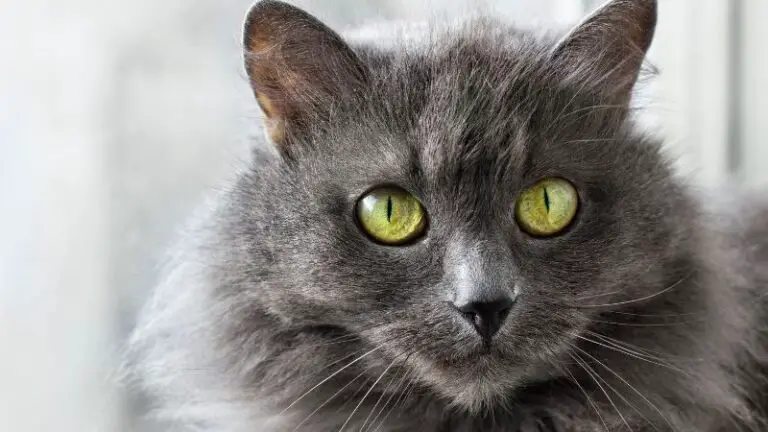GERMAN REX CAT PERSONALITY AND BREED (ALL YOU NEED TO KNW)
Would you like to know more about the German Rex cat personality? Since the 1930s, several people have reported mutations in the Rex breed in Germany. Still, recent genetic studies have shown that this variety is very similar to the Cornish Rex breed in England.
The German Rex is an intelligent, friendly cat who loves to play. At a glance, the German Rex descends from a stray cat, and the traditional color is black. However, he has a velvety coat and was near extinction once.
Let’s find out more about the German Rex cat personality and breed.

WHAT IS THE GERMAN REX CAT GENERAL ASPECT AND SIZE?
The German Rex is similar to the “cousins” Cornish Rex and Devon Rex for their characteristic curled hair. But the German Rex is an uncommon breed; even in feline exhibitions, finding one of these cats is challenging.
The German Rex has a sturdy build. However, he looks more like the European Shorthair than the Cornish Rex.
The hair tends to curl and assume the consistency of velvet. On the other hand, the whiskers are straighter than those of the Cornish Rex. The German rex has a bushy, thick tail at the base, a solid body, and well-developed muscles.
CHARACTERISTICS OF THE GERMAN REX CAT
| Characteristic | Description | Notes |
|---|---|---|
| In summary | A typical curly-haired variant of the Rex breed, born in Germany in the 1940s | It risked extinction, but now has a moment of glory in many parts of Europe |
| Personality | Lively and intelligent, very interested in what happens around him | |
| Appearance | Long legs, round muzzle, and large ears. The coat is short, curly, and silky | The whiskers are also usually slightly curled |
| In the house | Little noisy but extremely affectionate proves to be an ideal companion | |
| Behavior | If you take it in your arms gently and pamper him, he relaxes; gets nervous in environments he does not know | |
| Grooming | Just pat him to keep the fur in very good condition | Very similar mutation to that of the Cornish Rex |
| Most common health problems | There are no significant genetic diseases | |
| Size | Medium, around 5 kg | |
| Ears | Of medium size, rounded in the tips, well-spaced, and wide at the junction of the head. | |
| Eyes | Medium, round, and well-spaced | |
| Head | Triangular, with rounded lines with full cheeks and well developed | |
| Paws | Of medium length and tapered; oval feet and well developed | |
| Coat | Short, wavy, or curly, free of guard hair, and a little shaggy | |
| Allowed colors | The colors are all recognized, except for chocolate, lilac, and color point |
The German Rex has an imposing tail. It is almost long as the body and rather subtle.
▷ The range of colors allowed is vast, but solid colors, which means those without streaks, are the most popular.
The coat of the German Rex is bristlier and rougher than the Cornish Rex’s.
WHAT IS THE HISTORY OF THE GERMAN REX CAT?
In 1951 a doctor spotted an unusual black cat in the basement of a hospital in Berlin. Further research revealed that the animal had lived there since 1947 and had already given birth to kittens. It was called Lämmchen, which in German means “little lamb.”
The three kittens she gave birth to later, assisted by the doctor, all had normal coats, but when the only male was made to mate with the mother, two of the kittens born had the same singular hair as the mother.
Others like it were born, and when the new breed was shown in public for the first time at the cat show organized in 1960 in Paris, it attracted considerable attention. Such interest, however, unfortunately, didn’t last long.
SAVE BY A WHISKER!
Several kittens were exported to the United States, where they were crossed with Cornish Rex, but already at the death of Lämmchen, only a few specimens remained. Finally, towards the end of the 90s, the breed risked extinction but was saved by the dedication and effort of German and European breeders.
Perhaps the Rex gene on which this depends this mutation is more prevalent than one might think, since from time to time in the German feline population, there are some specimens with this characteristic coat, to the delight of hopeful breeders always in search of new crossings.
WHAT IS THE ORIGIN OF THE GERMAN REX CAT?
The first cat with a wavy coat known in Germany is Munk, a kitten born in 1930 from a Russian Blue and an Angora in Konigsberg, which was at the time Oriental Prussia.
But, all tracks of this strange feline were lost, without anyone caring about studying their genes. Then, in 1951 in a Berlin hospital, Dr. Rose Scheuer-Karpin was fascinated by the wavy fur of a tiny stray who lived in the hospital garden, and she decided to study the genetic heritage.
Initially, she did mate the kitten with her cat, quickly noticing that the gene responsible for that unusual coat was not dominant. Later, from a cross between Laemmchen (“little lamb,” in German), the name of the stray cat, and one of her children
two kittens with curly hair were born.
Once the recessivity of the gene is terminated, in collaboration with a Parisian geneticist, the doctor began seriously to breed these cats, crossing them with European specimens.
The selection also continued because of the work of other breeders, and in the 1960s, for the first time, the German Rex cats were presented in cat shows.
In America, there was a particular interest in this breed until their gene was found to be the same as the Cornish Rex, and ever since, the two species have been considered one.
Starting from the 80s, there was a recovered interest on the part of breeders and in
In 1982 the breed was officially recognized by FIFE.
✓ STRANGE, BUT TRUE!
In 1993 it was found on a construction site a tiny stray with a curly coat, which contributed to the resumption of the selection of the German Rex. The construction site was only 14 km from the hospital where Laemmchen had grown up forty years earlier!
GERMAN REX CAT PERSONALITY
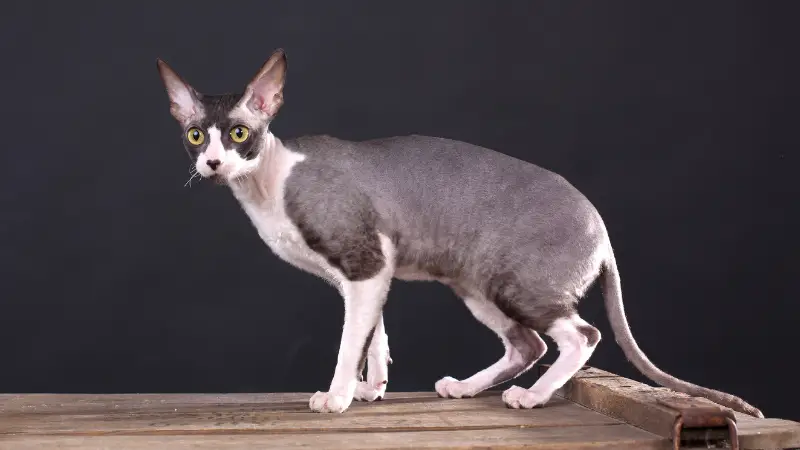
The German Rex is temperamentally very similar to the European cat and the cousin Cornish Rex. However, it is balanced, never subject to mood swings, patient, and turns out to be tireless and playful.
He tends to bond deeply with his master, but he is never intrusive in his displays of affection. Thus this is an ideal cat for those who do not want to have a cat too “clingy” or self-centered.
The German Rex is a skilled jumper, and his lively intelligence makes him a perfect cat for training. It turns out to be particularly friendly not only with other cats but also with other domestic animals.
While lively and playful, the German Rex is known for its peaceful and balanced character.
▷ The German Rex is a robust cat but suffers a little sudden changes in temperature.
HOW TO CARE FOR AND FEED THE GERMAN REX CAT
The German Rex is a sturdy cat that is in good health, even if, in the colder months tends to suffer a little the cold, and for this reason, it is recommended to cover the cat well if you decide to take him outside.
The coat of the German Rex requires very little care other than having a particularly poor moult.
As for the coat, it is necessary only a brush with soft brushes and, if the hair is light, a bath once in a while. For a more practical and faster cleaning, you can use special wipes, also perfect for polishing the hair.
AN ADVICE
One wipe with a damp chamois leather cloth is an excellent remedy to enhance the natural hedgehog of the mantle and counteract any ripple.
The ears should be cleaned on a weekly basis with a specific product or simply with a cotton swab soaked in warm water. For what concerns his diet, it can be said that German Rex eats just about anything.
But a balanced diet with meat, rice, and vegetables, administered in several small meals distributed throughout the day, is perfect for this cat.
AN ADVICE
If your little German Rex doesn’t show that gorgeous curly coat you expected, don’t worry: curls often change forms in kittens and then assume the characteristic appearance around the age of two.
FREQUENTLY ASKED QUESTIONS
What is the price of the German Rex cat?
You can expect a German Rex to cost between $500 and $1000. Unfortunately, this cat can be expensive because it is pretty rare. The price depends on the breeder, the purity of the breed, and the cat’s age.
What is the German Rex cat’s lifespan?
German Rex cats can live up to 14 years easily. The length of their life can depend on the quality of the food, the general care they receive, and the environment in which they live.
Do German Rex cats have health problems?
German Rex cats are not known to have any hereditary disease or health issues. However, they are known to suffer from a cold climate; if not covered or helped to stay warm, they can get colds or other infections.
Do German Rex cats shed?
German Rex cats are known not to shed much; they have a poor shedding routine. Therefore, to take care of their fur is necessary to brush them once in a while.
